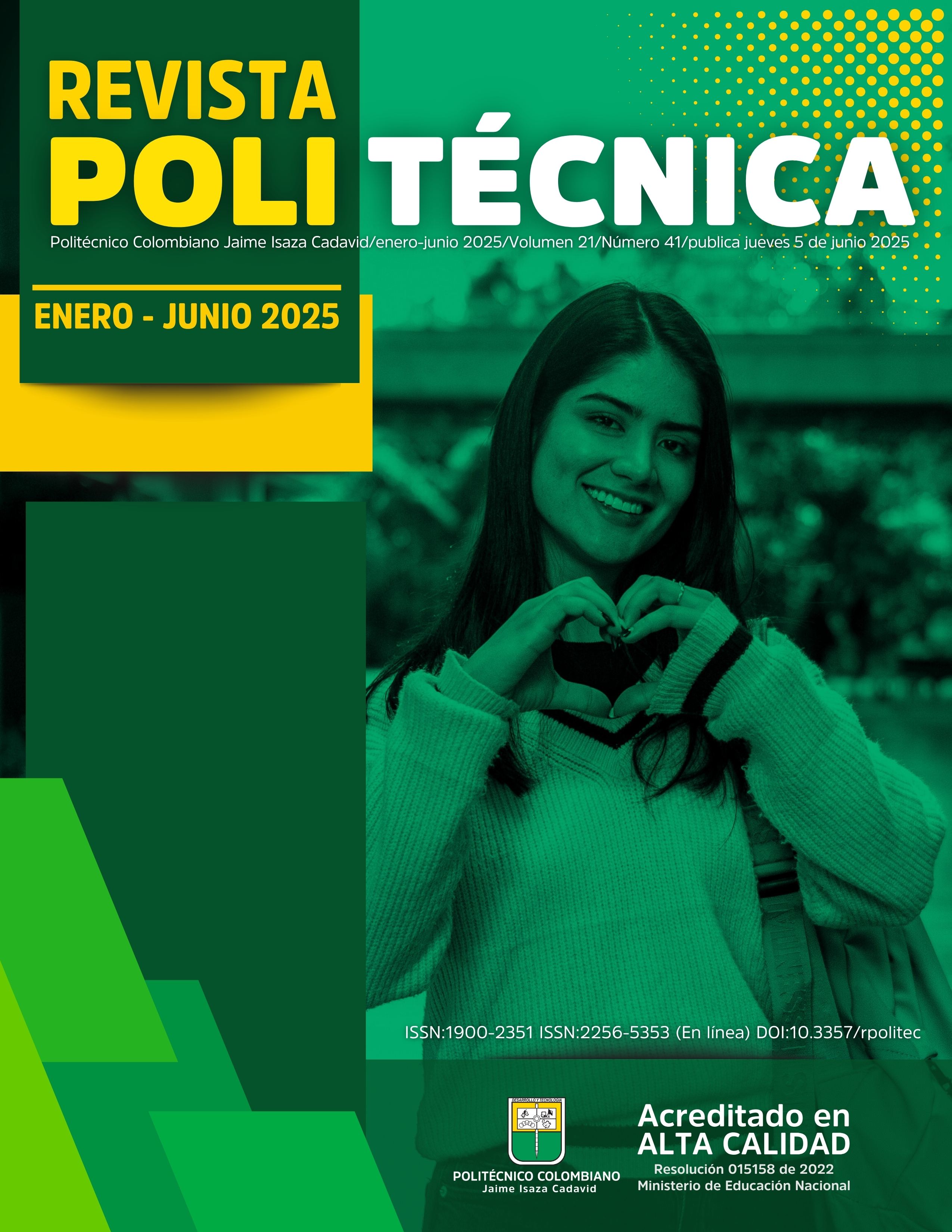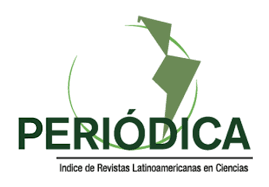Diatoms from a tropical river, Antioquia-Colombia
DOI:
https://doi.org/10.33571/rpolitec.v21n41a8Keywords:
diatomeas, bioindicación, epiliton, lista de chequeo, río de montañaAbstract
Epilithic diatoms and water physicochemical conditions were studied on the Tapartó river located in the municipality of Andes, Colombia. The periphyton was collected in four sampling campaigns, in three stations of the river: upper, middle and lower sections.The material was treated with hot peroxide samples were prepared in Naphrax for observation under an optical microscope and for observation under a scanning electron microscope. 49 diatoms were identified, of which the species Amphipleura chiapasensis, Cymbella cf. ehrenbergii, Encyonema minutiforme, Encyonema silesiacum, Pseudostaurosira aff. americana, Pseudostaurosira medliniae, Surirella bryophila are reported for the first time in Colombia, besides the physicochemical conditions are recorded in which the predominant diatoms are found. This information is important to incorporate it into biological monitoring methods that use diatoms and their bioindication values. This work increases the knowledge in the distribution of diatoms in the country and the physicochemical conditions to which they can be associated.
Article Metrics
Abstract: 319 PDF (Español (España)): 143PlumX metrics
References
[1] Restrepo, A. y Jaramillo, J. (1990). Resumen del Plan de Acción y recuperación y saneamiento de la micro-cuenca del Río Tapartó. Departamento administrativo de planeación. Dirección planeación del desarrollo. Divi-sión Territorial. Gobernación de Antioquia.
[2] GRUPOS GIGA y GAIA, (2002). Universidad de Antioquia; Posgrado en aprovechamiento de Recursos Hi-dráulicos, Universidad Nacional-sede Medellín. Caracterización cualitativa y cuantitativa de la calidad y cantidad del recurso hídrico superficial en la Cuenca del Río San Juan. Medellín
[3] Lowe, R.L. y Pan, Y. (1996). Benthic Algal Communities as Biological Monitors. Algal Ecology. 705 -738. DOI: https://doi.org/10.1016/B978-012668450-6/50051-5
[4] Patapova, M. y Charles, DF. (2007). Diatom metrics for monitoring eutrophication in rivers of United States. Ecological Indicators. 7: 48-70. https://doi.org/10.1016/j.ecolind.2005.10.001 DOI: https://doi.org/10.1016/j.ecolind.2005.10.001
[5] Díaz, C. y Rivera, C. (2004). Diatomeas de pequeños ríos andinos y su utilización como indicadoras de con-diciones ambientales. Limnología. 26(2): 381-394. https://bit.ly/3UrZzhL
[6] Sala S. Duque S., Núñez-Avellaneda M. y Lamaro A. (1999). Nuevos registros de diatomeas (Bacillariophy-ceae) de la Amazonia Colombiana. Caldasia, 21: 26–37.
[7] Sala S., Duque S., Núñez-Avellaneda M. y Lamaro A. (2002a). Diatoms fromthe Colombian Amazonia. Cryptogamie, Algologie 23: 75–99. DOI: https://doi.org/10.1016/S0181-1568(02)85009-7
[8] Sala S., Duque S., Núñez-Avellaneda M. y Lamaro A. (2002b). Diatoms from the Colombian Amazon: some species of the genus Eunotia (Bacillaryophyceae). Acta Amazonica, 32: 589–603. DOI: https://doi.org/10.1590/1809-43922002324603
[9] Sala S., Duque S., Núñez-Avellaneda M. y Vouilloud A. (2008a). Ultrastructure of the frustule of Urosolenia species from the Colombian and Peruvian amazon: U. delicatissima nov. spec., U. amazonica nov. spec. and U. braunii (Hustedt). Diatom Research, 23: 159–169. DOI: https://doi.org/10.1080/0269249X.2008.9705744
[10] Vouilloud A., Sala S., Núñez-Avellaneda M. y Duque S. (2010). Diatoms from the Colombian and Peruvian Amazon: the genera Encyonema, Encyonopsis and Gomphonema (Cymbellales, Bacillariophyceae). Revista de Biología Tropical/International Journal of Tropical Biology, 58: 45–62. DOI: https://doi.org/10.15517/rbt.v58i1.5193
[11] Montoya-Moreno, Y., Sala, S., Vouilloud A. y Aguirre, N. (2011). Capartogramma crucicula (Grunow ex Cle-ve) Ross, primer registro del género para Colombia. Universitas scientiarum. Vol. 16 N° 1: 70-76.
10.11144/javeriana.SC16-1.ccge DOI: https://doi.org/10.11144/javeriana.SC16-1.ccge
[12] Montoya-Moreno, Y., Sala, S.E., Vouilloud, A. y Aguirre, N. (2012). Diatomeas (Bacillariophyta) perifíticas del complejo cenagoso de Ayapel, Colombia. I. Caldasia 34: 457–474.
[13] Simonato J., Kociolek J.P., Sala S.E., Díaz Y.P. y Núñez-Avellaneda M. (2020). Three new Luticola species from the Andean-Amazonian transition in Colombia: taxonomy, morphology and preliminary considerations of the biogeography of the genus. Diatom Research, 1–17. https://doi.org/10.1080/0269249X.2020.1813205 DOI: https://doi.org/10.1080/0269249X.2020.1813205
[14] Vouilloud, A., Sala, S., Núñez-Avellaneda, M., Montoya-Moreno, Y. y Duque, S. (2014).Brachysira (Navicu-lales, Bacillariophyceae) in lowland waters from Colombia. Diatom research, 29(2),147-163 https://doi.org/10.1080/0269249X.2013.866909 DOI: https://doi.org/10.1080/0269249X.2013.866909
[15] Sala S., Ramírez J., y Plata-Díaz Y. (2008b). Diatoms from lentic and lotic systems in Antioquia, Chocó and Santander Departments in Colombia. Revista de Biología Tropical/ International Journal of Tropical Biology, 56: 1159–1178. https://doi.org/10.15517/rbt.v56i3.5701 DOI: https://doi.org/10.15517/rbt.v56i3.5701
[16] Sala S. y Ramírez J. (2008). Cyclotella katiana nov. sp. (Bacillariophyceae) from La Reina Swamp, Parque Nacional los Katíos, Colombia. Diatom Research, 23: 147–157. DOI: 10.1080/0269249X.2008.9705743 DOI: https://doi.org/10.1080/0269249X.2008.9705743
[17] Medina-Tombé, M., Sala, S., Vouilloud A. y Ramírez-Restrepo, J. (2016). Surirella tayronarum spec. nov. (Surirellaceae, Bacillariophyta) from Colombia. Phytotaxa 278 (1): 039–047. http://dx.doi.org/10.11646/phytotaxa.278.1.4. DOI: https://doi.org/10.11646/phytotaxa.278.1.4
[18] Medina-Tombé, M., Sala, S., Vouilloud A. y Ramírez-Restrepo, J. (2017). Comparación morfológica y distri-bución geográfica de las especies Tabellaria fenestrata y Tabellaria flocculosa (Bacillariophyceae) en sistemas lóticos y lénticos de Colombia. Actual Biol 39 (107): 43-50. https://doi.org /10.17533/udea.acbi.v39n107a05 DOI: https://doi.org/10.17533/udea.acbi.v39n107a05
[19] Vouilloud, A., Plata-Díaz, Y., Pedraza, E., Pimienta, A., Heguilor, S., Lamaro, A. y Sala, S. (2016). Distribu-ción de Eunotia parasiolii (Bacillariophyceae) en ríos neotropicales (Colombia) y su implicancia en la taxonomía de la especie. HIDROBIOLÓGICA, 26(2), 241–250. https://doi.org/10.24275/uam/izt/dcbs/hidro/2016v26n2/Vouilloud DOI: https://doi.org/10.24275/uam/izt/dcbs/hidro/2016v26n2/Vouilloud
[20] Medina-Tombé, M., Vouilloud A y Sala, S. (2019). Terpsinoë música Ehrenberg (Bacillariophyceae), primer registro del género para Colombia. Actual Biol 41 (110): 5-13, 2019 | DOI: https://doi.org/10.17533/10.17533/udea.acbi.v41n110a01
https://doi.org /10.17533/udea.acbi.v41n110a01
[21] Sala, S., Vouilloud, A., Plata Díaz, Y, Pedraza. E., y Pimienta, A. (2015). Taxonomía y distribución de dia-tomeas epilíticas registradas por primera vez en Colombia I. Caldasia 37(1):125. DOI: 10.15446/caldasia.v37n1.50814 DOI: https://doi.org/10.15446/caldasia.v37n1.50814
[22] BJ Bellinger, C. Cocquyt y O'Reilly, CM. (2006). Diatomeas bentónicas como indicadores de eutrofización en corrientes tropicales”, Hydrobiologia, vol. 1, núm. 573, págs. 75-87.
http://dx.doi.org/10.1007/s10750-006-0262-5 DOI: https://doi.org/10.1007/s10750-006-0262-5
[23] ALCALDÍA DE BETANIA. (2006). Plan de Saneamiento y Manejo de Vertimiento municipio de Betania. Alcal-día municipal de Betania. https://es.calameo.com/books/0048451017da8b8ae2127.
[24] Olmos, C. A, Molina, R.D., Vélez, F. y Aguirre, N. (2015). Efectos de la descarga de materia orgánica pro-veniente de subproductos de la agroindustria del café sobre el oxígeno disuelto del río Tapartó en el suroeste Antioqueño. Trabajo de grado en ingeniería Ambiental. Grupo Geolimna. Escuela Ambiental. Facultad de inge-niería. Universidad de Antioquia.
[25] CEN/TC 230. (2002). Water quality-Guidance standard for the routine sampling and pretreatment of benthic diatoms from rivers. European Standard. CEN/TC 230 prEN 13946: Committee on European Normalization 14 p. Recuperado de (www.techind.fi/standard/uutiset/tilaajat/sfs_en_12952-6.pdf).
[26] Patrick R. y Reimer, WC. (1966). The diatoms of United States. Philadelphia, vol 1. Monogr. Acad. Nat. Sci., Philadelphia. 688p.
[27] Patrick R. y Reimer, WC. (1975). The diatoms of United States. Philadelphia, vol 2. Monogr. Acad. Nat. Sci., Philadelphia. 212p.
[28] Germain, H. (1981). Flore des diatomées. Diatomophycées. Societé Nouvelle des Editions Boubée, France.
[29] Gasse, F. (1986). East Africans Diatoms: Taxonomy, ecological distribution. Bibliotheca Diatomologica, Band 11. J. Cramer, Berlin-Stuttgart. 295p. DOI: https://doi.org/10.1007/978-94-009-4808-2_12
[30] Round, F., Crawford, Y. y Mann, DG. (1990). The diatoms. Biology y morphology of the genera. Cambridge: Cambridge University Press. 776p.
[31] Lange-Bertalot, H. (1993). 85 New Taxa and much more the 100 taxonomic clarifications supplementary to Süßwasserflora von Mitteleuropa. Vol. 2/1-4. Bibliotheca Diatomologica, 27. J. Cramer, Berlin-Stuttgart.
[32] Lange-Bertalot, H. (2001). Diatoms of Europe. Diatoms of the European Inland Waters and Comparable Habitats. Navicula sensu stricto 10 Genera separated from Navicula sensu lato Frustulia. A.R.G. Gantner K.G., Ruggel, Germany.
[33] Lange-Bertalot, H., K. Külbs, T. Lauser, M. Nörpel- Schempp. y Willman, M. (1996). Diatom taxa introduced by Georg Krasske Documentation and Revision. Iconographia Diatomologica. Annotated Diatom Micrographs. Volume 3. Koeltz Scientific Books, Königstein, Germany.
[34] Metzeltin, D. y Lange-Bertalot, H. (1998). Tropical diatoms of South America I. In: Lange-Bertalot. H. (Ed.). Iconographia Diatomologica 5. Koeltz Scientific Books. Germany. 695p.
[35] Metzeltin, D. y Lange-Bertalot, H. (2007). Tropical diatoms of the South America II. Iconographia Diatomo-logica 18: A.R.G. Gantner Verlag K.G. Koenigstein. Germany. 877p.
[36] Metzeltin, D., H. Lange-Bertalot, y García-Rodríguez, F. (2005). Diatoms of Uruguay. Iconographia Diatomo-logica 15: A.R.G. Gantner Verlag K.G. Koenigstein. Germany. 695p.
[37] Montoya-Moreno Y, Sala S, Vouilloud A, Aguirre N, Plata Y. (2013). Lista de las diatomeas de ambientes continentales de Colombia. Biota Colombiana 14 (2): 13-78. Recuperado de https://revistas.humboldt.org.co/index.php/biota/article/view/282
[38] Biggs, B. y Kilroy, C. (2000). Stream Periphyton Monitoring Manual. NIWA, Christchurch. The New Zealand Ministry for the Environment. New Zeland.
[39] Martínez, L.F. y Donato, J. (2003). Efectos del caudal sobre la colonización de algas en un río de alta mon-taña tropical (Boyacá, Colombia). Limnología. 25(2): 337-354. Recuperado de https://revistas.unal.edu.co/index.php/cal/article/view/39386
[40] Acs, É., Szabó, K., Kiss, Á. K., Tóth, B., Záray, G. y Kiss, K. (2006). Investigation of epilithic algae on the River Danube from Germany to Hungary and the effect of a very dry year on the algae of the River Danube. Archive für Hydrobiologie 158:389–417. Recuperado de https://www.researchgate.net/publication/286726367_Benthic_algal_investigations_in_the_Danube_river_and_some_of_its_main_tributaries_from_Germany_to_Hungary DOI: https://doi.org/10.1127/lr/16/2006/389
[41] De Fabricius, A., Maidana, N., Gómez, N. y Sabater, S. (2003). Distribution patterns of benthic diatoms in a Pampean river exposed to seasonal floods: the Cuarto River (Argentina). Biodiversity and Conservation,12: 2443–2454. https://doi.org 10.1023/A:1025857715437 DOI: https://doi.org/10.1023/A:1025857715437
[42] Béres, V., Török, P., Kókai, Z., Krasznai, E.T, Tóthmérész, B. y Bácsi, I. (2014). Ecological diatom guilds are useful but not sensitive enough as indicators of extremely changing water regimes. Hydrobiologia. 738:191–204. https://doi.org 10.1007/s10750-014-1929-y DOI: https://doi.org/10.1007/s10750-014-1929-y
[43] Passy, S. I. (2007). Diatom ecological guilds display distinct and predictable behavior along nutrient and disturbance gradients in running waters.Aquatic Botany. 86:171–178 https://doi.org10.1016/j.aquabot.2006.09.018 DOI: https://doi.org/10.1016/j.aquabot.2006.09.018
[44] Margalef, R. (1983). Limnología. Ediciones. Omega. Barcelona.
[45] Moro, R.S. y Fürstenberger, CB. (1997). Catálogo dos principalis parámetros ecológicos de diatomáceas não-marinhas. Universidad Estadual de Ponta Grossa. Paraná. 282p.
[46] Pandey, L. K., Kumar, D., Yadav, A., Rai, J.y Gaur, J. P. (2014). Morphological abnormalities in periphytic diatoms as a tool for biomonitoring of heavy metal pollution in a river. Ecological indicators, 36: 272-279. https://doi.org/10.1016/j.ecolind.2013.08.002 DOI: https://doi.org/10.1016/j.ecolind.2013.08.002
[47] Montoya-Moreno, Y. y AGUIRRE, N. (2013). Knowledge to Ecological Preferences in a Tropical Epiphytic Algae to Use with Eutrophication Indicators. Journal of Environmental Protection, 4: 27-35 DOI: https://doi.org/10.4236/jep.2013.411A004
https://doi.org/ 10.4236/jep.2013.411A1004
[48] Weilhoefer, C. L. y Pan, Y. (2007). Relationships between diatoms and environmental variables in wetlands in the Willamette valley, Oregon, USA. Wetlands, 27, No. 3. pp. 668–682. DOI: https://doi.org/10.1672/0277-5212(2007)27[668:RBDAEV]2.0.CO;2
https://doi.org/ 10.1672/0277-5212(2007)27[668:RBDAEV]2.0.CO;2
[49] Biggs, B.J.F., Stevenson, R.J.y LOWE, R. (1998). A habitat matrix conceptual model for stream periphyton. Archives of Hydrobiology. 143: 21–56. Recuperado de https://www.researchgate.net/publication/240311199A_habitat_matrix_conceptual_model_for_stream_periphyton DOI: https://doi.org/10.1127/archiv-hydrobiol/143/1998/21
[50] Ivorra, N., Barranguet, C., Jonker, M., Kraak, M. y Admiraal, W. (2002). Metal-induced tolerance in the fresh-water microbenthic diatom Gomphonema parvulum. Environmental Pollution, 116. 147–157. https://doi.org/10.1016/S0269-7491(01)00152-X DOI: https://doi.org/10.1016/S0269-7491(01)00152-X
[51] Falasco, E., Bona, F., Badino, G., Hoffmann, L. y Ector, L. (2009). Diatom teratological forms and environ-mental alterations: a review. Hydrobiologia. 623:1–35. https://doi.org/ 10.1007/s10750-021-04540-x DOI: https://doi.org/10.1007/s10750-008-9687-3
Downloads
Published
How to Cite
Issue
Section
License
Copyright (c) 2025 Yimmy Montoya-Moreno, Karol Vanessa Solorzano-Ramírez, Néstor Jaime Aguirre-Ramírez, Fabio de Jesús Vélez-Macías

This work is licensed under a Creative Commons Attribution-NonCommercial-ShareAlike 4.0 International License.


























